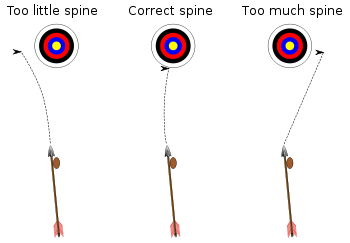
Archer's paradox
Encyclopedia

Details
In order to be accurate, an arrow must have the correct stiffnessStiffness
Stiffness is the resistance of an elastic body to deformation by an applied force along a given degree of freedom when a set of loading points and boundary conditions are prescribed on the elastic body.-Calculations:...
, or "spine", to flex out of the way of the bow and return back to the correct path as it leaves the bow. Incorrect spine results in unpredictable contact between the arrow and the bow, therefore unpredictable forces on the arrow as it leaves the bow, and therefore reduced accuracy. Additionally, if an archer shoots several arrows with different spine, even if they clear the bow they will be deflected on launch by different amounts and so will strike in different places. Competition archers therefore strive not only for arrows that have a spine within a suitable range for their bow, but also for highly consistent spine within sets of arrows.
Choice of bow and spine
Less powerful bows require arrows with less spine. Less powerful bows have less effect in deforming the arrow as it is accelerated (see "Euler" bucklingBuckling
In science, buckling is a mathematical instability, leading to a failure mode.Theoretically, buckling is caused by a bifurcation in the solution to the equations of static equilibrium...
, case I) from the bow and the arrow must be "easier" to flex around the riser of the bow before settling to its path. Conversely, powerful bows need stiffer arrows with more spine, as the bow will have a much greater bending effect on the arrow as it is accelerated.
An arrow with too much spine for the bow will not flex and as the string comes closer to the bow stave, the arrow will be forced off to the side. Too little spine, or flexion, will result in the arrow deforming too much and being propelled off to the other side of the target. In extreme cases, the arrow may break before it can accelerate, which can be a safety hazard.
Calibration
The measurement of "spine" has been standardised by the American Archery Trade AssociationArchery Trade Association
The Archery Trade Association, formerly known as the Archery Manufacturer and Merchant's Organization, is a non-profit trade organization for the promotion of archery and bowhunting through sale of equipment, projects in archery education, the standardization of equipment measures, and the...
, formerly the Archery Manufacturer's Organization, and spine measurements may sometimes be specified as "AMO spine". The spine of an arrow shaft is a measure of its stiffness. The AMO standard for measuring spine is to measure the deflection of the shaft at the midpoint of a 26 inches (66 cm) span when placed under a load of 2 pound-forces (8.9 N). The more deflection, the less stiff the shaft, and the lower its spine measurement.

